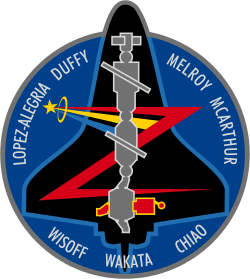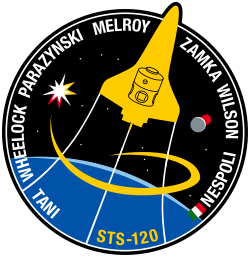Pamela Melroy
| Pamela A. Melroy | |
 | |
| NASA-astronaut | |
|---|---|
| Född | 17 september 1961[1] Palo Alto, Kalifornien |
| Tidigare yrke | Pilot |
| Tid i rymden | 38 dagar, 20 timmar, 4 minuter |
| Urvalsgrupp | Astronautgrupp 15 |
| Uppdrag | STS-92, STS-112, STS-120 |
| Uppdragsemblem | |

Pamela A. Melroy, född 17 september 1961 i Palo Alto, Kalifornien, är en amerikansk astronaut uttagen i astronautgrupp 15 den 9 december 1994.[1]
Karriär
Melroy tog bachelorexamen 1983 från Wellesley College med astronomi och fysik som huvudämnen. Hon blev samtidigt genom ROTC officer i USA:s flygvapen. Året därpå tog hon en masterexamen geovetenskap och planetologi från Massachusetts Institute of Technology (MIT). I flygvapnet kom hon att tjänstgöra som pilot för lufttankningsplanet KC-10 Extender vid förband på Barksdale Air Force Base i sex år. 1991 påbörjade hon provflygarutbildningen vid Edwards Air Force Base i Kalifornien. Efter examen kom Melroy att arbeta med utprovning av C-17 Globemaster III.
I december 1994 valdes Melroy ut som astronautkandidat. Hennes första rymdfärd var med STS-92 år 2000. Hon blev 2007 den andra kvinnan i historien, efter Eileen Collins, att föra befäl på en rymdfärja under STS-120.
Den 21 juni 2021 tillträde hon som viceadministratör för NASA.[2]
Rymdfärder
Familjeliv
Melroy är gift med Douglas Hollett[1] och har inga barn.
Se även
Referenser
- ^ [a b c d] ”Biographical Data” (på engelska) (PDF). NASA. 17 april 2025. https://www.nasa.gov/sites/default/files/atoms/files/melroy_pamela.pdf. Läst 22 juni 2021.
- ^ Jackie McGuinness (21 juni 2021). ”Pam Melroy Sworn in as NASA Deputy Administrator” (på engelska). NASA. https://www.nasa.gov/press-release/pam-melroy-sworn-in-as-nasa-deputy-administrator. Läst 22 juni 2021.
Externa länkar
 Wikimedia Commons har media som rör Pamela A. Melroy.
Wikimedia Commons har media som rör Pamela A. Melroy.
Media som används på denna webbplats
Författare/Upphovsman: Cmichel67, Licens: CC BY-SA 4.0
Pam Melroy in 2022 at JSC by Christopher Michel
Designed by the crew members, the STS-92 patch symbolizes the second mission to carry U.S.-built elements to the International Space Station (ISS) for assembly. The black silhouette of the Space Shuttle Discovery stands out against the deep blue background of space in low Earth orbit. In the foreground in gray is a profile view of the ISS as it appears when the shuttle and crew arrive, with the station consisting of the Unity node, its two pressurized mating adapters (PMA), the Zarya functional cargo block, the Zvezda service module, and the Progress cargo vehicle.
Following the shuttle's rendezvous and docking, the ISS configuration will be augmented by the two elements delivered by Discovery–the Z1 truss and PMA-3. These two elements, depicted in red, will be installed using the shuttle's robot arm and be connected to ISS during four spacewalks. The multi-national nature of both the STS-92 crew and the ISS are reflected in the multi-colored Astronaut Office symbol.
The STS-112 emblem symbolizes the ninth assembly mission (9A) to the International Space Station (ISS), a flight which is designed to deliver the Starboard 1 (S1) truss segment. The 30,000 pound truss segment will be lifted to orbit in the payload bay of the Space Shuttle Atlantis and installed using the ISS robotic arm. Three space walks will then be carried out to complete connections between the truss and ISS. Future missions will extend the truss structure to a span of over 350 feet so that it can support the solar arrays and radiators which provide the electrical power and cooling for ISS. The STS-112 emblem depicts ISS from the viewpoint of a departing shuttle, with the installed S1 truss segment outlined in red. A gold trail represents a portion of the Shuttle rendezvous trajectory. Where the trajectory meets ISS, a nine-pointed star represents the combined on-orbit team of six shuttle and three ISS crew members who together will complete the S1 truss installation. The trajectory continues beyond the ISS, ending in a six-pointed star representing the Atlantis and the STS-112 crew.
The STS-120 patch reflects the role of the mission in the future of the space program. The shuttle payload bay carries Node 2, the doorway to the future international laboratory elements on the International Space Station. On the left the star represents the International Space Station; the red colored points represent the current location of the P6 solar array, furled and awaiting relocation when the crew arrives. During the mission, the crew will move P6 to its final home at the end of the port truss. The gold points represent the P6 solar array in its new location, unfurled and producing power for science and life support. On the right, the moon and Mars can be seen representing the future of NASA. The constellation Orion rises in the background, symbolizing NASA's new exploration vehicle. Through all, the shuttle rises up and away, leading the way to the future.





